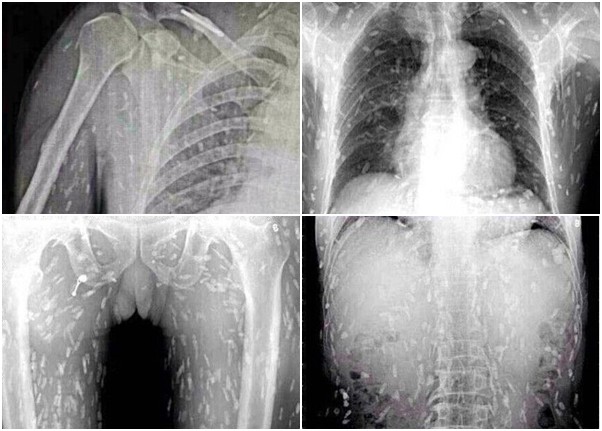Origin
In September 2014, images of x-rays were circulated on Chinese-language web sites accompanied by the claim that they documented a man whose body had become riddled with tapeworms he had contracted from consuming sashimi (i.e., raw fish):

The Chinese-language web site hk.on.cc then published an article stating that medical officials had confirmed the x-rays as genuine:
Recently x-rays were circulated on the Internet showing a body seemingly containing swarms of white insects. The Fifth Affiliated Hospital of Guangdong confirmed that these x-rays were of a patient from the Shunde District who spent 14 days in the hospital after complaining of severe abdominal pains and itchy skin. After the patient revealed one of his favorite foods was raw fish, additional x-rays and a medical examination were undertaken, his condition was judged to be serious, and he was sent to a hospital Guangzhou for further treatment.
Dr. Yin of Guangzhou's No.8 People's Hospital said that the dense white spots seen in the x-rays were worms, and that a lot of people are eating infected food containing tapeworm eggs and thereby contracting cysticercosis (i.e., a parasitic pork tapeworm infection that creates cysts in different areas in the body). Dr. Yin pointed out that wild snakes, fish, pork, and beef consumed raw are most likely to be infected with such tapeworms (especially fish raised in freshwater ponds, which are often contaminated with feces).
Dr. Yin also pointed out then when people consume foods containing tapeworm eggs, the eggs make their way into the digestive system where they are absorbed as nutrients. As the eggs hatch, the larvae are spread throughout the body via the bloodstream, and they may even enter into the brain and develop into cerebral cysticercosis. Dr. Yin said that tapeworms in other parts of the body may be treated through methods that kill them, but it is difficult to use such treatment on tapeworms in the brain as it may cause cerebral edema and endanger the patient's life.
At Guangdong 999 Brain Hospital, neurosurgeon Hai Dengxing said that two months ago he had admitted a female student who complained of cramps and appeared to be suffering from memory loss. The patient said she had recently eaten raw frogs, and a brain scan revealed irregular shadows and white spots which turned out to be parasites infecting her brain.
This information was picked up and passed along by the dubious Central European News agency, which passed it along to Western media outlets such as BuzzFeed and the Daily Mail, who unquestioningly ran it as straight news — even though it bore a strong resemblance to the fictitious backstory of another image that has been circulated widely on the Internet for several years (one which is falsely claimed to show a man whose brain became "infected with maggots" through his consumption of sushi).
This news item as presented had some contradictory details (possibly due to translation issues), referencing tapeworms contracted through the consumption of raw fish but then discussing a type of tapeworm found only in pork. In fact, the x-ray images were similar to those included in a 2014 case report published by the British Medical Journal that dealt with a man who contracted a rare case of disseminated cysticercosis through the consumption of uncooked pork (with no mention of raw fish):
We present the case of a 74-year-old patient who, as an adult, enjoyed eating uncooked pork and beef. Recently, he had suffered from a sudden onset of gait disturbance, memory loss and disturbance of consciousness. He was brought to the emergency department for evaluation. On arrival, his vital signs were stable. The physical examination revealed mild weakness of the right extremities (muscle strength grade 3/5), slurred speech, left facial palsy and general appearance of weakness. ELISA was positive, as were serum and cerebrospinal fluid (CSF) parasite antibody immunoglobulin G for cysticercosis. We strongly suspected neurocysticercosis.
The brain CT scan, brain MRI, abdominal CT scan and plain X-rays had a characteristic 'starry sky' appearance, revealing calcified foci in muscles. Treatment of neurocysticercosis lesion includes administration of albendazole and steroids, and surgical ventriculoperitoneal shunting to alleviate the symptoms.
Disseminated cysticercosis is a very rare infectious disease. It is important to recognise disseminated cysticercosis clinically and to perform appropriate radiological investigations, because this condition requires an appropriate therapy. Patients who have not undergone treatment and who have active cysts remain at a risk of serious complications.
In summary, what these images show is the aftermath of a parasitic tapeworm infection caused by the eating of raw or undercooked pork, not sashimi. And what's viewable in the x-rays are not the tapeworms themselves, but rather calcified cysts that were the end result of the infection.

